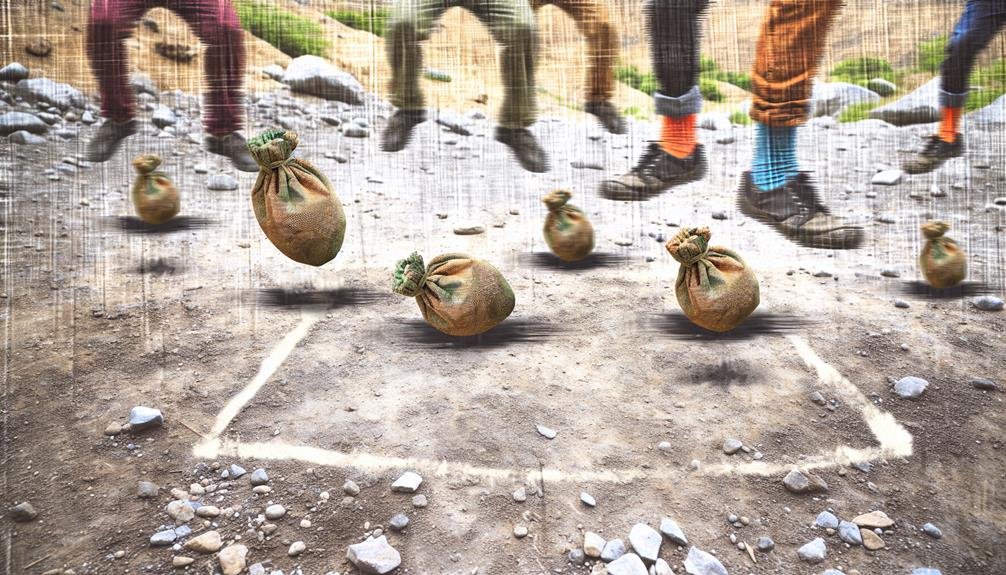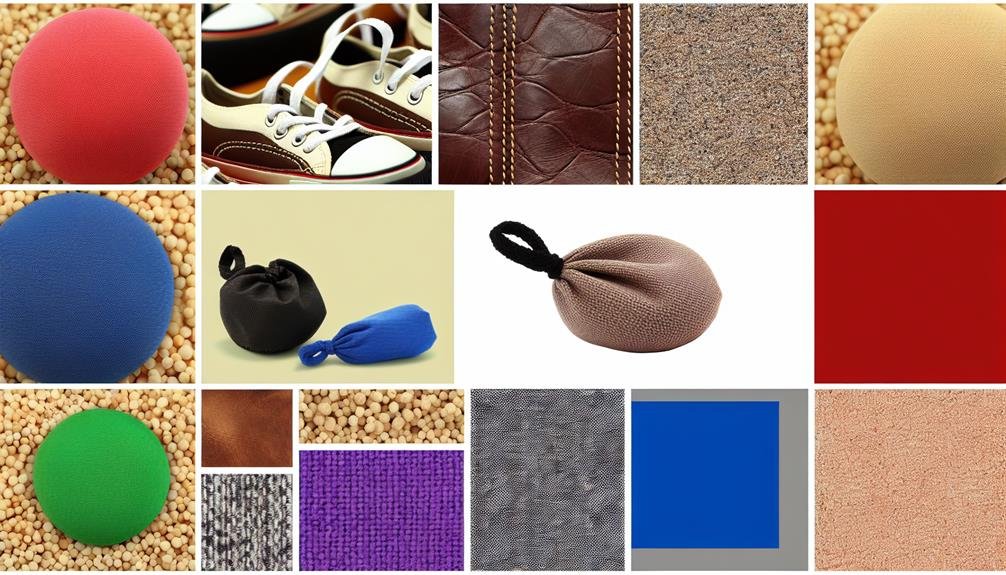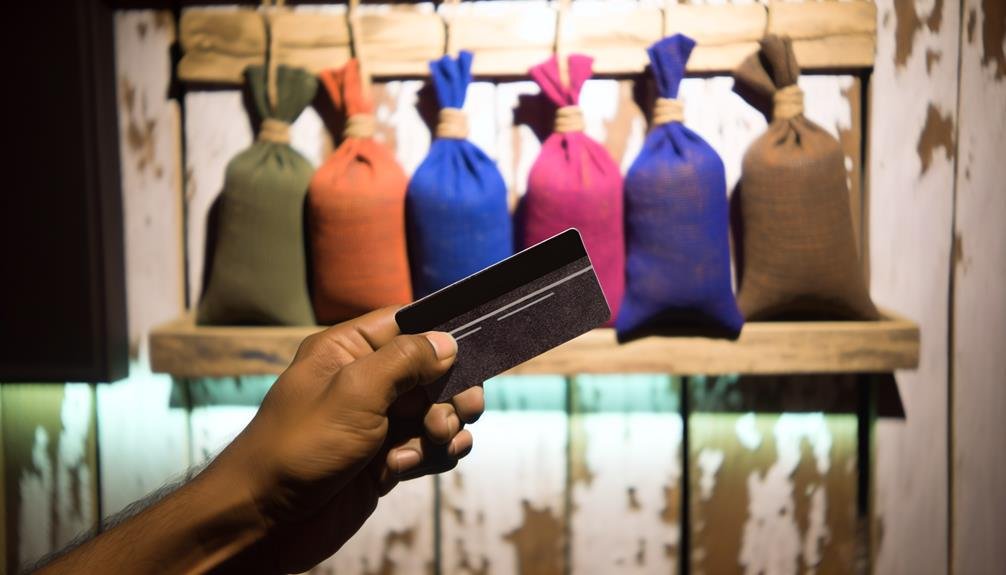Dirt Bags Hacky Sacks are excellent. They were born in the ’70s counterculture and made hacky sack a worldwide sensation. Stitched by hand in the USA, each bag has perfect balance and high durability. Synthetic materials aid longevity, resisting wear and tear. Your skills improve with dirtbags, which help with stall control precision. When buying, check quality, weight, and weather resistance. You keep them crisp with gentle cleaning, dry storage, and prompt repair. Now that you’re clued in on Dirt Bags, why not explore some wicked tricks you can pull off with them, like the Clipper and Around the World?
Key Takeaways
- Dirt Bags Hacky Sack originated in the 1970s counterculture movement, contributing to the game’s global popularity.
- They are hand-stitched in the USA, ensuring a consistent shape, size, weight balance, and superior durability.
- Dirt Bags are made from synthetic or organic materials, with the synthetic version being cheaper and more durable.
- Proper care, such as gentle cleaning and storing in a dry, cool place, can prolong the lifespan of Dirt Bags.
- They can enhance your hacky sack skills, such as stall control and precision, and allow for exciting tricks like Clipper and Around the World.
Origins of Dirt Bags
To truly understand the appeal of Dirt Bags hacky sack, you need to explore its intriguing origins. This isn’t just a game of foot dexterity. It’s a product born out of a counterculture movement in the 1970s. Here’s how it came about: two hippies, John Stalberger, and Mike Marshall, invented the concept in Oregon. But it wasn’t until the 1980s that Dirt Bags took the concept and ran with it.
So, what’s different about Dirt Bags? They didn’t just create a product; they built a brand. Their hacky sacks aren’t mass-produced in a factory. They’re hand-stitched by artisans in the USA, using a unique blend of materials and techniques. This gives each Dirt Bag its distinct character.
It’s also worth noting that Dirt Bags was one of the first companies to recognize the game’s potential as a sport. They’ve sponsored players, organized tournaments, and helped establish professional standards.
In short, Dirt Bags didn’t just jump on the hacky sack trend. They were instrumental in shaping it, turning a simple pastime into a global phenomenon. And that’s a large part of their appeal.
What Sets Dirt Bags Apart
Diving into Dirt Bags’ distinct qualities reveals various factors that set these hacky sacks apart. Unlike other brands, Dirt Bags are recognized for their unique design and superior performance.
There’s more to them than meets the eye. Here’s what you need to know:
- Consistent Shape and Size: Dirt Bags maintain their form even after extensive use, which isn’t always the case with other brands.
- Perfect Weight: Their weight is carefully calibrated to provide the best balance between control and momentum.
- Superior Stitching: Dirt Bags are known for their durable stitching, allowing for prolonged use without tearing.
- Excellent Balance: They offer outstanding balance, making them a favorite among enthusiasts and professionals.
- Distinctive Design: Finally, Dirt Bags’ unique and attractive design sets them apart from other hacky sacks in the market.
Materials Used in Dirt Bags
You’re likely curious about what goes into making dirtbags, specifically the materials used.
So, let’s start by comparing synthetic versus organic materials and closely examine their different attributes.
We’ll also discuss the durability of these materials, helping you understand how each holds up under the rigors of play.
Synthetic Vs. Organic Materials
In hacky sack production, there’s an ongoing debate about using synthetic and organic materials for Dirt Bags, each offering unique advantages and drawbacks. You might wonder, ‘Which material should I choose?’ To help you decide, let’s explore a detailed analysis of both options.
Consider these factors:
- Production Cost: Synthetic materials are often cheaper, while organic materials can be more expensive.
- Environmental Impact: Organic materials are generally more eco-friendly than synthetic ones.
- Allergenicity: Some people may have allergic reactions to synthetic materials.
- Weight and Feel: The weight and feel of the Dirt Bag can vary depending on the material used.
- Availability: Synthetic materials are usually more readily available than organic ones.
Ultimately, your choice will depend on your specific needs and preferences.
Durability of Different Materials
When evaluating the durability of different materials used in Dirt Bags, it’s important to highlight that synthetic materials often outlast their organic counterparts. Materials such as nylon or polyester are more resistant to wear and tear, making your Dirt Bag last longer. They’re also less likely to absorb moisture, which can degrade the material over time.
Contrastingly, organic materials such as leather or cotton, while providing a more natural feel, tend to wear out faster. They’re more susceptible to moisture absorption and can degrade quicker when subjected to harsh weather conditions. So, if you’re looking for a hacky sack that will withstand rough play and last longer, you might want to consider those made of synthetic materials.
Enhancing Skills With Dirt Bags
Mastering the art of hacky sacks requires consistent practice, and Dirt Bags provide an excellent tool for honing these skills. Their unique construction and weight distribution offer a distinct advantage for those wanting to improve their footbag skills.
Dirt Bags can help refine several aspects of your hacky sack game, such as:
- Stall Control: Dirt bags’ heavy weight lends itself well to practicing stalls, as they stay in place better than lighter bags.
- Precision: Dirt bags’ unique weight distribution can help enhance your aim, allowing for more accurate kicks and passes.
- Juggling: The predictable arc of a Dirt Bag’s flight makes it great for practicing juggling, especially for beginners.
- Consistency: Dirt bags’ uniform size and weight promote consistency in your play, helping you sharpen your skills faster.
- Durability: Dirt Bags withstand rigorous practice, and their resilience ensures they maintain their shape and feel over time, providing reliable feedback.
Buying Your First Dirt Bag
Ready to purchase your first Dirt Bag? Consider several factors, such as quality, size, weight, and material, to ensure you invest in a product that will enhance your hacky sack skills.
Quality is paramount. A high-quality Dirt Bag will withstand vigorous kicks and tosses, lasting longer than cheaper alternatives. Look for reinforced stitching and durable materials that can endure the rigors of play.
Size and weight matter, too. Generally, a standard Dirt Bag weighs around 50 grams and is about 2 inches in diameter. But remember, it’s your comfort that counts. Test different sizes and weights to find what feels best for you.
The final consideration is the material. Dirt Bags are typically made from suede or leather, known for their strength and longevity. However, they also come in synthetic materials like nylon, which can be more affordable and weather-resistant.
Caring for Your Dirt Bag
Now that you’ve got your Dirt Bag, it’s important to understand how to maintain it properly.
From cleaning techniques to storage and regular maintenance, we’ll cover everything you need to maintain your sack.
Also, we’ll discuss how to repair your sack if it is damaged.
Proper Cleaning Techniques
Understanding the correct cleaning techniques is crucial to maintaining your dirtbag in excellent condition. Here’s a list of steps to guarantee your hacky sack stays clean and durable without compromising its integrity.
- Carefully remove excess dirt: Don’t be too forceful; you don’t want to damage the stitching.
- Use gentle soap: Harsh chemicals can deteriorate the material over time.
- Pat dry, don’t squeeze: Squeezing can distort the shape and affect your game.
- Avoid direct sunlight when drying: This can cause the color to fade.
- Never machine wash or dry: This can cause severe damage.
Storage and Maintenance
After ensuring your Dirt Bag is clean, the next step is understanding how to properly store and maintain it to prolong its lifespan and performance.
Always store your sack in a dry, cool place away from direct sunlight. Excessive heat can cause the material to break down over time, while moisture can lead to mildew and mold. Avoid storing it in areas with sharp objects or heavy items that could crush it.
Regularly check your Dirt Bag for signs of wear and tear. If you notice small holes or frayed stitching, addressing these issues promptly is important. However, refrain from making any repairs, which will be covered in the next section.
Proper care and storage can significantly extend the longevity of your Dirt Bag.
Repairing Your Sack
Should your Dirt Bag sustain any damage, knowing how to repair it properly can save you the cost of a replacement and guarantee it continues to perform at its best.
Here are five analytical steps to repair your Dirt Bag:
- Inspect the Damage: Carefully inspect your Dirt Bag for any visible damages. This could be anything from small tears to burst seams.
- Gather Supplies: You’ll need a needle, thread, and possibly some replacement fabric.
- Prep the Repair: Clean the damaged area and, if necessary, cut away any frayed threads.
- Sew It Up: Use a sturdy stitch to close any tears or loose seams.
- Check Your Work: After repairing, give your Dirt Bag a good toss to ensure it holds up under stress.
With these steps, you’ll keep your Dirt Bag in the game longer.
Exciting Dirt Bag Tricks to Try
Spicing up your hacky sack game involves learning new, thrilling tricks with your Dirt Bag. These tricks not only test your skills but also add an element of excitement to the game. Let’s explore a few that you can try.
First is the ‘Clipper‘. This trick involves intercepting the sack mid-flight with the inside of your foot raised backward toward your posterior. It’s an impressive move that demands agility and balance.
Next is the ‘Stall.’ In this trick, you catch the sack on a flat body surface, like the foot or the back of your hand, and hold it momentarily before kicking it back up. This trick tests your control and precision.
Conclusion
So, you’re now well-versed in the fascinating world of Dirt Bags. Whether you’re drawn to their unique origins, intrigued by the materials used, or excited to perfect your skills, there’s no denying their allure. Remember the tricks you’ve learned while purchasing and caring for your first Dirt Bag. With practice and passion, you’re set to become a Dirt Bag Hacky Sack master. It’s not just a game; it’s an adventure. Plunge in!
FAQs
What Tournaments or Competitions Are Available for Dirt Bags Hacky Sack Players?
Various tournaments for hacky sack players are held globally, like the World Footbag Championships. Local competitions are also common. For upcoming events, check the International Footbag Players’ Association website.
Are There Any Professional Dirt Bags Hacky Sack Players I Can Watch or Follow?
Yes, there are professional players you can follow. They often participate in tournaments or competitions. You can watch their performances on sports channels or online platforms or follow their social media for updates and tips.
Can Dirt Bags Hacky Sack Be Played Both Indoors and Outdoors?
Certainly, you can play it both indoors and outdoors. Just make sure you’ve enough space to kick around. Outdoors, it’s mostly played on grass or sand. Indoors, a large enough room would be suitable.
Is There a Recommended Age or Skill Level to Start Playing With Dirt Bags Hacky Sack?
Yes, there’s no specific age or skill level to start. It’s a game you can learn at any age. Younger players might initially find it challenging, but they’ll improve with practice.
Are There Any Health Benefits Associated With Playing Dirt Bags Hacky Sack?
Yes, there are health benefits. You’re improving your balance, coordination, and flexibility. It’s an aerobic activity, so you’re also boosting your heart health. Plus, it’s a great stress reliever, adding to mental well-being.




